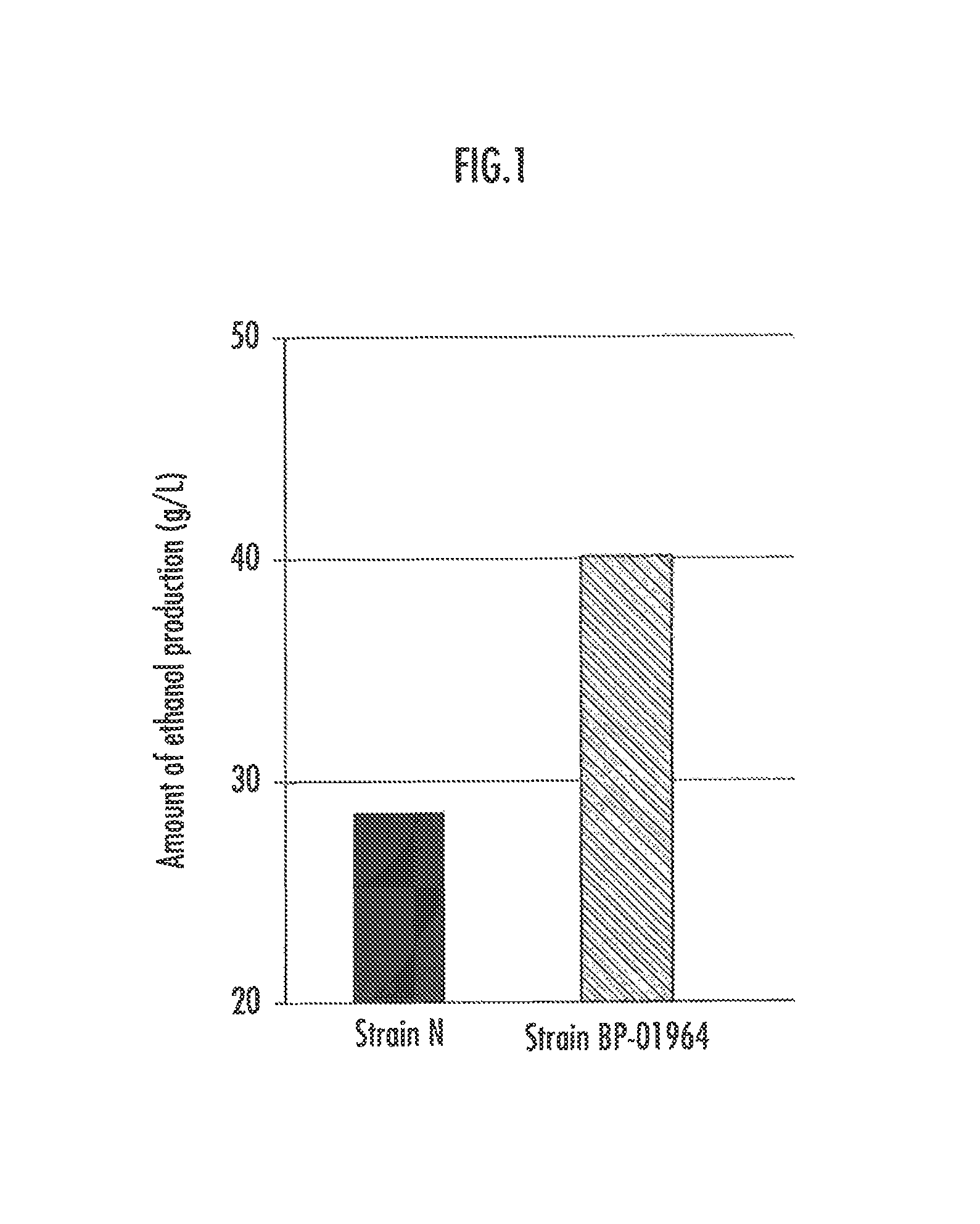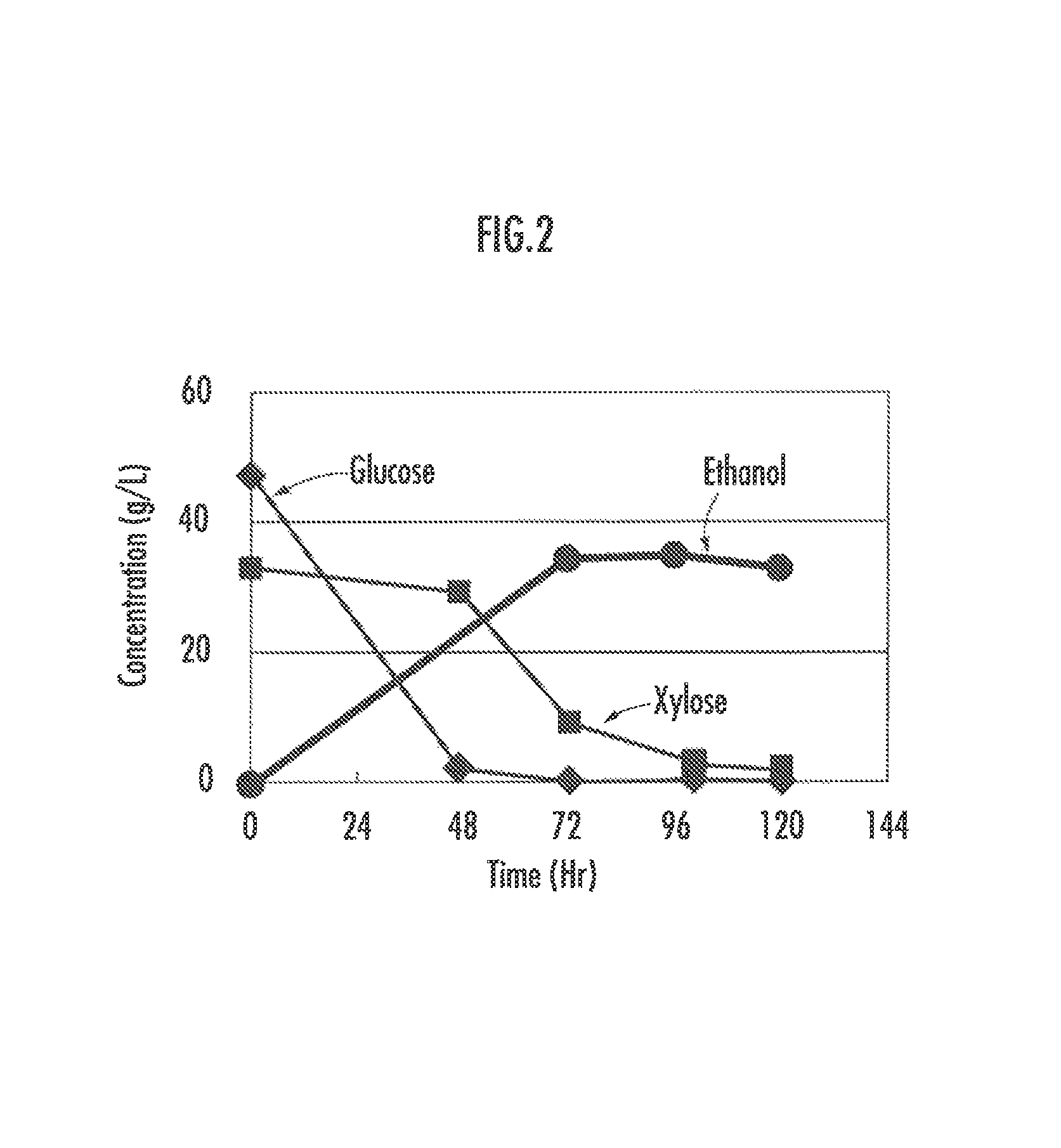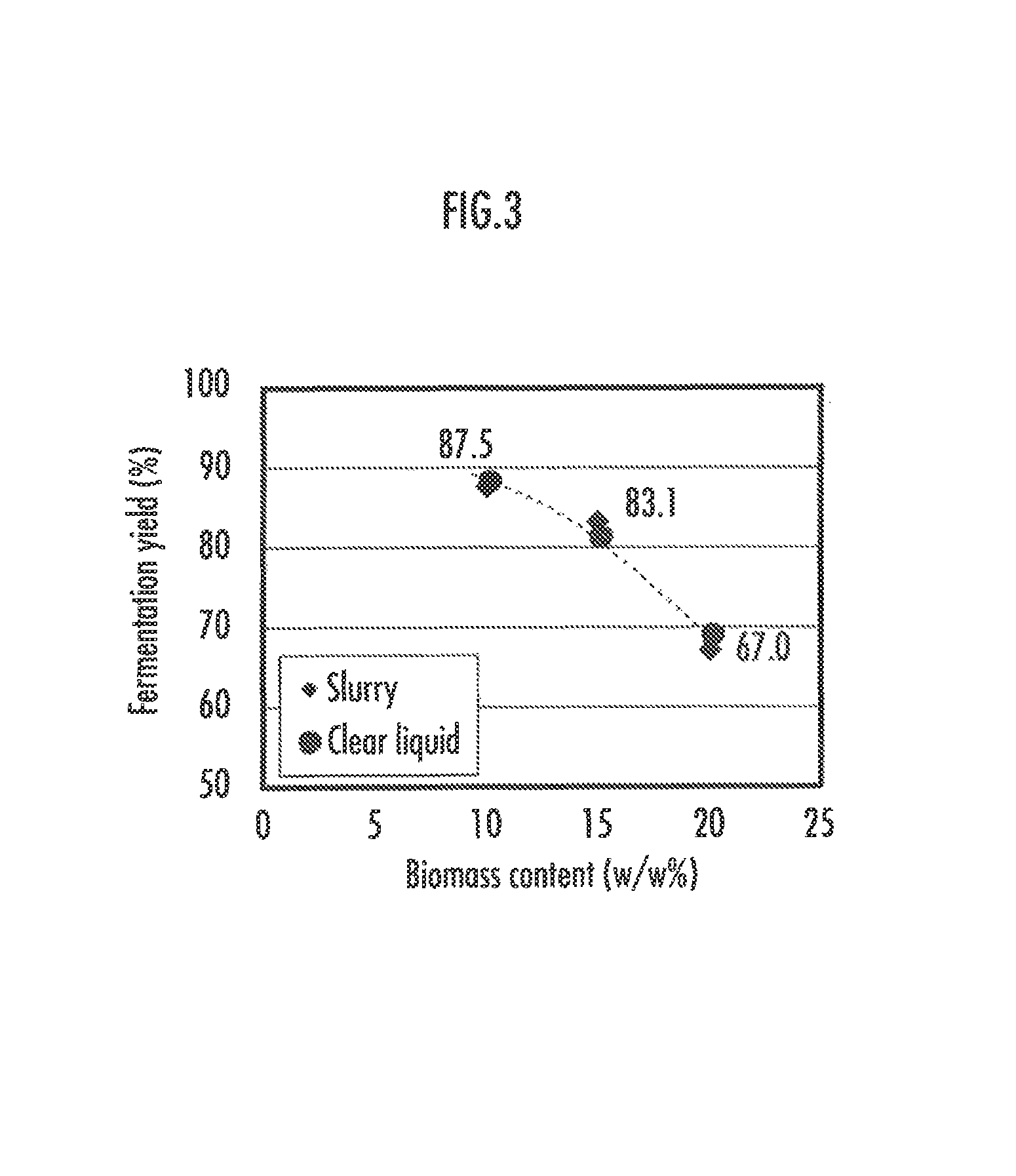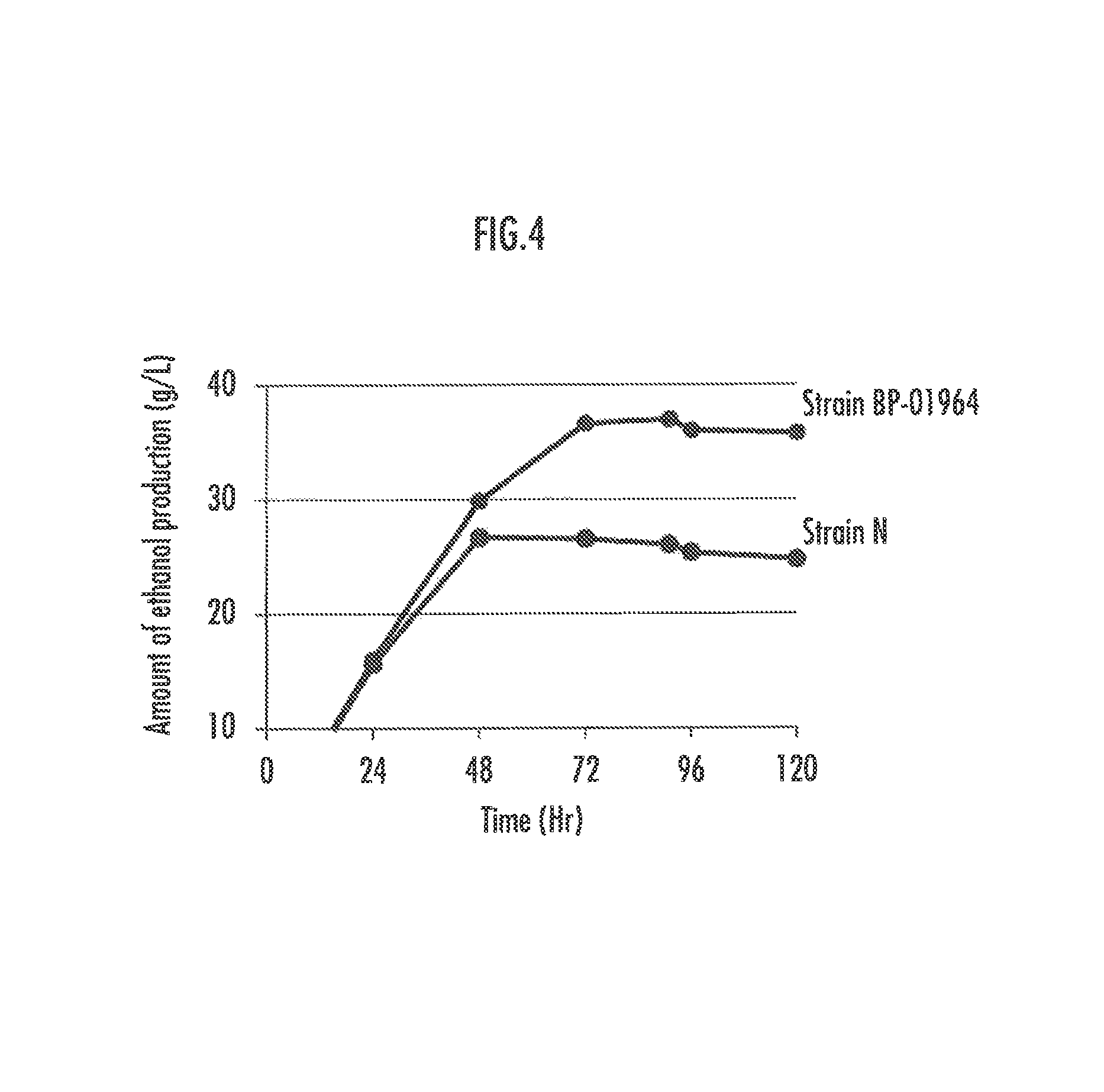Highly efficient ethanol-fermentation yeast
Tsuchida , et al.
U.S. patent number 10,294,497 [Application Number 15/532,826] was granted by the patent office on 2019-05-21 for highly efficient ethanol-fermentation yeast. This patent grant is currently assigned to HONDA MOTOR CO., LTD.. The grantee listed for this patent is HONDA MOTOR CO., LTD.. Invention is credited to Akihiko Aoyagi, Ikumi Kurihara, Yoshiki Tsuchida, Norihiko Tsukagoshi.




| United States Patent | 10,294,497 |
| Tsuchida , et al. | May 21, 2019 |
Highly efficient ethanol-fermentation yeast
Abstract
An object of the present invention is to obtain fermentative yeast having highly efficient ethanol production without introducing a foreign gene. A further object is to obtain a fermentative yeast that is resistant to proliferation inhibitors such as organic acids, which prevent the proliferation of the fermentative yeast. Meyerozyma guilliermondii that can produce ethanol effectively from pentose and hexose was isolated by breeding. Moreover, resistance was imparted to the fermentative yeast by introducing transaldolase and alcohol dehydrogenase genes derived from Meyerozyma guilliermondii into the fermentative yeast.
| Inventors: | Tsuchida; Yoshiki (Saitama, JP), Tsukagoshi; Norihiko (Saitama, JP), Kurihara; Ikumi (Saitama, JP), Aoyagi; Akihiko (Saitama, JP) | ||||||||||
|---|---|---|---|---|---|---|---|---|---|---|---|
| Applicant: |
|
||||||||||
| Assignee: | HONDA MOTOR CO., LTD. (Tokyo,
JP) |
||||||||||
| Family ID: | 56091243 | ||||||||||
| Appl. No.: | 15/532,826 | ||||||||||
| Filed: | December 5, 2014 | ||||||||||
| PCT Filed: | December 05, 2014 | ||||||||||
| PCT No.: | PCT/JP2014/082329 | ||||||||||
| 371(c)(1),(2),(4) Date: | June 02, 2017 | ||||||||||
| PCT Pub. No.: | WO2016/088272 | ||||||||||
| PCT Pub. Date: | June 09, 2016 |
Prior Publication Data
| Document Identifier | Publication Date | |
|---|---|---|
| US 20180237803 A1 | Aug 23, 2018 | |
| Current U.S. Class: | 1/1 |
| Current CPC Class: | C12P 7/06 (20130101); C12R 1/84 (20130101); C12R 1/645 (20130101); C12N 15/102 (20130101); C12N 15/09 (20130101); Y02E 50/10 (20130101) |
| Current International Class: | C12P 7/06 (20060101); C12N 15/10 (20060101); C12N 15/09 (20060101) |
References Cited [Referenced By]
U.S. Patent Documents
| 2013/0189788 | July 2013 | Zhang et al. |
| 2011-024500 | Feb 2011 | JP | |||
| 2011-167096 | Sep 2011 | JP | |||
| 2011-193788 | Oct 2011 | JP | |||
| 2012-170422 | Sep 2012 | JP | |||
| 2011/065539 | Jun 2011 | WO | |||
Other References
|
Han Li-Li et al., "Breeding of Higher Ethanol Fermentation of Xylose Strain with Protoplast Fusion and Mutagenisis", Liquor Making, vol. 35, No. 2, Mar. 2008, pp. 38-41, Sinkiang, China, Listed in International Search Report, English abstract included, 4 pages. cited by applicant . T. Granstrom et al., "Chemostat study of xylitol production by Candida guilliermondii", Appl Microbiol Biotechnol (2001) 55, pp. 36-42, Mar. 7, 2000, listed in International Search Report, English text, 7 pages. cited by applicant . Paul A. Bicho et al., "Induction of Xylose Reductase and Xylitol Dehydrogenase Activities in Pachysolen tannophilus and Pichia stipitis on Mixed Sugars", Applied and Environmental Microbiology, Jan. 1988, vol. 54, No. 1, pp. 50-54, Ontario, Canada, Discussed in specification, English text, 5 pages. cited by applicant . Cesar Fonseca et al., "L-Arabinose metabolism in Candida arabinofermentans PYCC 5603T and Pichia guilliermondii PYCC 3012: influence of sugar and oxygen on product formation", Appl Microbiol Biotechnol (2007), vol. 75, pp. 303-310, Listed in International Search Report, English text, 8 pages. cited by applicant . Min Zhang et al., "Metabolic Engineering of a Pentose Metabolism Pathway in Ethanologenic Zymomonas mobilis", Science, Jan. 13, 1995, vol. 267, pp. 240-243, Discussed in specification, English text, 6 pages. cited by applicant . Olena P. Ishchuk et al., "Overexpression of pyruvate decarboxylase in the yeast Hansenula polymorpha results in increased ethanol yield in high-temperature fermentation of xylose", FEMS Yeast Res (2008), pp. 1164-1174, English text, 11 pages. cited by applicant . International Search Report, dated Mar. 17, 2015 (dated Mar. 17, 2015), 2 pages. cited by applicant . European Search Report dated Apr. 25, 2018, 6 pages. cited by applicant . Schirmer-Michel, et al. "Production of Ethanol from Soybean Hull Hydrolysate by Osmotolerant Candida Guilliermondii NRRL Y-2075", Science Direct, Biosource Technology 99 (2008), pp. 2898-2904, 7 pages. cited by applicant . Matsushika, et al. "Ethanol Production from Xylose in Engineered Saccharomyces cerevisiae Strains: Current State and Perspectives", Appl Microbiol. Biotechnol (2009) 84:37-53, 17 pages. cited by applicant. |
Primary Examiner: Holland; Paul J
Attorney, Agent or Firm: Rankin, Hill & Clark LLP
Claims
The invention claimed is:
1. An ethanol-fermentative yeast, the ethanol-fermentative yeast being effective to produce ethanol from pentose and hexose and deposited to NITE Patent Microorganisms Depositary under the accession number NITE BP-01964 into which at least one gene selected from self-cloned pyruvate decarboxylase and formate dehydrogenase is introduced.
Description
TECHNICAL FIELD
The present invention relates to a yeast for fermenting a saccharified solution in bioethanol production using lignocellulosic biomass.
In particular, the present invention relates to a yeast capable of effectively producing ethanol from pentose (which may be, hereinafter, also referred to as C5) and hexose (which may be, hereinafter, also referred to as C6) in bioethanol production using lignocellulosic biomass.
BACKGROUND ART
Bioethanol is expected to be a renewable resource that is produced by biomass. Moreover, since carbon dioxide that is produced by combustion of bioethanol is carbon neutral, increased use of bioethanol is considered to suppress increase of carbon dioxide, which is a main cause of the global warming.
Bioethanol is obtained by fermenting biomass and distilling and purifying ethanol. It is necessary to produce much alcohol from saccharified solutions for increasing the yield of bioethanol. Since the yeasts generally used in the process of bioethanol production cannot convert pentose such as xylose and arabinose into alcohol, only hexose has been used as raw materials for fermentation.
Typical biomass is reported to contain 35-45% of cellulose, 25-40% of hemicellulose, and 15-30% of lignin, though the contents vary according to raw materials. Therefore, use of hemicellulose, which mainly contains the pentose xylose, but not only cellulose, which is a polymer of hexose, as a substrate should lead to effective ethanol production.
Xylose is reported to be the second abundant sugar in biomass next to glucose and it is an important object in bioethanol production to use pentose effectively.
Techniques for using xylose, even at a little amount, by imparting the ability to utilize xylose by genetic recombination, using microorganism that produces ethanol from xylose, or the like have been so far disclosed.
Patent Literature 1 discloses an invention involving converting xylose (C5) into xylulose by introducing a gene having the xylose transporter activity into a host cell to incorporate it in the pentose phosphate pathway of the glycolysis and use it for fermentation.
Patent Literature 2 discloses a technique for producing alcohol with yeast provided with an arabinose transporter. This involves incorporation of arabinose (C5) via arabitol and xylulose in the pentose phosphate pathway in the glycolysis to use it for fermentation, similar to the invention of Patent Literature 1.
Non-Patent Literature 1 discloses provision of xylose utilization ability by incorporating a xylose utilization gene derived from Escherichia coli in Zymomonas.
Non-Patent Literature 2 describes production of ethanol from xylose by yeast in the genus Pichia.
CITATION LIST
Patent Literature
Patent Literature 1: Japanese Patent Laid-Open No. 2012-170422 Patent Literature 2: U.S. Patent Application Publication No. 2013/189788
Non Patent Literature
Non Patent Literature 1: Zhang, M., et al., Science, 1995. Vol. 267, pp. 240-243. Non Patent Literature 2: Bicho, P. A., et al., Appl. Environ. Microbiol., 1988, Vol. 54, pp. 50-54.
SUMMARY OF INVENTION
Technical Problem
However, the invention of Patent Literature 1 involves introducing a protein having the xylose transporter activity derived from Candida guilliermondii into Saccharomyces cerevisiae as a host. Accordingly, a foreign gene would be introduced.
The invention of Patent Literature 2 is also an invention involving introduction of a gene from a species different from the host, although the transporter gene is different.
The technique described in Non-Patent Literature 1 also involves introduction of a xylose utilization gene. The technical concept thereof is different from Patent Literature 1 and 2 described above, but they are similar in that a foreign gene is introduced.
Therefore, any of the invention described in Patent Literature 1 and 2 and Non-Patent Literature 1 requires adopting a containment measure to comply with "the Cartagena Protocol on Biosafety to the Convention on Biological Diversity" adopted in the United Nations. Accordingly, they require facilities for ensuring the biosafety and therefore it is disadvantageous in cost to produce ethanol using such yeasts.
Moreover, use of yeast in the genus Pichia by the technique described in Non-Patent Literature 2 does not result in a much higher efficiency of ethanol production because the low xylose availability in the wild-type Pichia yeast.
An object of the present invention is to obtain a fermentative yeast having a highly efficient ethanol production without introducing a foreign gene.
Solution to Problem
The present invention features a fermentative yeast that effectively produces ethanol from pentose and hexose and is deposited to NITE Patent Microorganisms Depositary (NITE Patent Microorganisms Depositary, National Institute of Technology and Evaluation (Independent Administrative Institution), #122, 2-5-8 Kazusakamatari, Kisarazu-shi, Chiba 292-0818, Japan) on Nov. 19, 2014 (accession date) under the accession number NITE BP-01964 (hereinafter, also referred to as strain BP-01964).
The wild-type Meyerozyma guilliermondii has a xylose utilization ability. However, it does not have sufficient ability to utilize xylose for the bioethanol production. The strain BP-01964 was obtained by the strain improvement of Meyerozyma guilliermondii and selection of yeasts that utilize pentose at a high efficiency. As a result, a yeast comprising ethanol productivity about twice as high as that of the parental strain was selected.
Moreover, the present invention features introduction of a self-cloned transaldolase, alcohol dehydrogenase, pyruvate decarboxylase, xylose reductase, xylitol dehydrogenase, transketolase, or formate dehydrogenase into the aforementioned Meyerozyma guilliermondii strain.
The introduction of an enzyme gene from Meyerozyma guilliermondii itself does not necessitate any containment measure to comply with the Cartagena Act. Therefore, conventional facilities can be used without needing special facilities for biosafety.
BRIEF DESCRIPTION OF DRAWINGS
FIG. 1 illustrates the amounts of ethanol production in the strain BP-01964 and the parent strain (the strain N).
FIG. 2 illustrates glucose and xylose utilization abilities in slurry fermentation.
FIG. 3 illustrates yields of fermentation in slurry fermentation and in clear liquid fermentation.
FIG. 4 illustrates the ethanol production ability of the strain BP-01964 with a corn stover clear liquid.
DESCRIPTION OF EMBODIMENTS
The ascomycete yeast Meyerozyma guilliermondii comprises the xylose utilization ability. A yeast of the accession number NITE BP-01964 was obtained using the strain N of Meyerozyma guilliermondii as the parent strain by the breeding involving selection of mutants with mutagenesis.
In general, mutagenesis involves use of irradiation of ultraviolet rays or radioactive rays, alkylating agents such as N-ethyl-N-nitrosourea (ENU) and ethyl methanesulfonate (EMS), base analogs such as BrdU, or nitroso compounds such as nitroamine or nitrosoguanidine. In the present invention, mutagenesis was carried out by irradiation of UV or addition of a chemical such as EMS.
Methods for obtaining yeast strains are described below.
Examples
1. Isolation of Yeast Strain
The parent strain of Meyerozyma guilliermondii was cultured with a sugar solution derived from rice straw. Rice straw from Kumagaya, Japan was immersed in an equal amount of a 25% ammonium solution at 80.degree. C. for 3 hours and then ammonia was allowed to be evaporated. The pH of the treated biomass was adjusted to 4 with 10% NaOH and then Acremonium cellulase (manufactured by Meiji Seika Pharma Co., Ltd.) was added to conduct enzymatic saccharification at 50.degree. C. for 72 hours. The solid-liquid separation of the produced slurry was conducted by filter-pressing to collect the liquid. Using this liquid (hereinafter, also referred to as clear liquid), habituation in culture was conducted with addition of a mutagen for 19 months and strains with improved fermentation performance were selected. The selection was based on the amount of ethanol after a certain time period. A strain with high fermentation performance was deposited to NITE Patent Microorganisms Depositary, National Institute of Technology and Evaluation (Independent Administrative Institution) under the accession number NITE BP-01964.
2. Properties of the Strain
2.1 Ethanol Production Ability
FIG. 1 illustrates the amount of ethanol production in the strain BP-01964 in comparison with that of the strain N, the parent strain. Corn stover was treated with dilute sulphuric acid and the resultant saccharified liquid whose pH was adjusted to 6 with an NaOH aqueous solution was used. A liquid culture of the strain was added so that the OD.sub.600 of the medium became 2.0 and the resultant liquid culture was cultured at 30.degree. C. for 96 hours. The amount of ethanol after the culturing is illustrated. Glucose in the saccharified solution was 63.2 g/L and xylose was 34.5 g/L. Ethanol was measured using GC-FID (manufactured by GL Sciences Inc.: GC390B).
As seen in FIG. 1, the obtained strain produces ethanol more than 2 times as much as the wild type does. Since the obtained strain has an improved ethanol production relative to the wild type strain, the obtained strain is considered to have an improved ability to utilize xylose, which is C5. Therefore, the glucose and xylose utilization abilities of the strain were examined.
Next, rice straw was treated with an ammonium aqueous solution in a similar way to the ammonia treatment described above and then Acremonium cellulase was added to conduct enzymatic saccharification at 50.degree. C. for 72 hours. Fermentation was conducted using the produced slurry.
The slurry fermenter has a jacket structure and the temperature was regulated by the circulation of warm water through the jacket part. Air ports are provided at the bottom and fermentation was conducted with continuously providing a predetermined amount of filtered air through the air ports at the bottom with agitation with impellers coupled with a motor.
The change over time in amount of glucose, xylose, and ethanol contained in the slurry was analyzed. Glucose and xylose were measured by sampling and centrifuging the slurry and measuring the resultant supernatant by HPLC. Ethanol was measured using GC-FID (manufactured by GL Sciences Inc.: GC390B) as described above. The result is shown in FIG. 2.
Glucose, which is C6, is consumed earlier, but as glucose in the slurry decreases, xylose, which is C5, is consumed to produce ethanol. Since the obtained yeast comprises both C5 and C6 utilization abilities, it can produce ethanol efficiently. Therefore, it is a strain that is also useful in industrial production.
2.2 Slurry Fermentation Ability, Clear Liquid Fermentation Ability
A yeast that efficiently carries out fermentation both with slurry and with clear liquid in the bioethanol production is preferred. Therefore, the fermentation yields with slurry and with clear liquid were compared. The fermentation yield is calculated by the following equation. Fermentation yield=amount of obtained ethanol (g/L)/amount of glucose+xylose contained in sugar solution at the onset of fermentation (g/L)/0.5114
As illustrated in FIG. 3, the obtained strain can exhibit equivalent performance both in slurry fermentation and in clear liquid fermentation.
2.3 Ethanol Production Ability with Corn Stover Sugar Liquid
Like rice straw, corn stover is biomass often used for bioethanol production. The obtained strain efficiently produces bioethanol with corn stover as well, although it is a strain isolated by conducting habituation with a clear liquid produced from rice straw.
Corn stover from Iowa, the United States, was immersed into 2 times volume of 3.7% by weight sulfuric acid aqueous solution and treated at 170.degree. C. for 10 minutes. After transfer to normal temperature, pH of the solution was adjusted to pH 4 with a 4 M sodium hydroxide aqueous solution and an enzyme for biomass saccharification (such as Acremonium cellulase, manufactured by Meiji Seika Pharma Co., Ltd.) was added to conduct enzymatic saccharification at 50.degree. C. for 72 hours. The solid-liquid separation of the produced slurry was conducted by centrifugation to collect the liquid (hereinafter, referred to as corn stover clear liquid).
Fermentation with a corn stover clear liquid whose pH was adjusted to pH 6 with an NaOH aqueous solution was conducted with the obtained strain and the amount of ethanol production was measured over time. The result is shown in FIG. 4. While the ethanol production of the wild type (the strain N) reaches a plateau after 48 hours, the obtained strain continues producing ethanol until 72 hours later and can produce ethanol at a final yield that is about 1.5 times as high as that of the wild type.
Moreover, transaldolase, which is an enzyme in the pentose phosphate pathway, alcohol dehydrogenase, which is an enzyme that produces ethanol from acetaldehyde, or pyruvate decarboxylase, which produces acetaldehyde, which is a substrate of alcohol dehydrogenase from pyruvic acid, can be genetically introduced into the strain obtained in the present invention to further facilitate use of xylose.
For example, the following procedures can be adopted for the genetic introduction. Amplify the gene to be introduced and a terminator region thereof (hereinafter, referred to as gene+terminator region) by PCR. Amplify a promoter region to be used for the introduction. These should be both amplified by PCR from the chromosomes of the strain of Meyerozyma guilliermondii used in the present invention.
Clone the DNA fragments amplified by PCR into a commercially available vector for Escherichia coli by infusion in the order of promoter, gene+terminator region. Transform Escherichia coli with the cloned vector and amplify the vector. Obtain DNA fragments for homologous recombination by cutting out the promoter and gene+terminator region from the amplified vector with restriction enzymes or amplifying the promoter and gene+terminator region from the amplified vector by PCR
Homologous recombination of the strain with the obtained DNA fragments was performed to obtain a desired strain. Electroporation was used for the homologous recombination. Genetic introduction in this manner allows introduction of multiple copies into the chromosomes and therefore enhancement of the activity of the introduced enzyme.
As a DNA fragment for the homologous recombination, for example, the promoter of xylose reductase, transaldolase+terminator may be preferably used because transaldolase is considered to work efficiently when using the promoter of xylose reductase that functions in the xylose utilization.
Specifically, the xylose reductase promoter is amplified with the following primers of SEQ ID NO: 1 and SEQ ID NO: 2 and the transaldolase gene and the terminator region were amplified with the following primers of SEQ ID NOs: 3 and 4.
TABLE-US-00001 SEQ ID NO: 1: AAGGCTTGGGAACTTTCTTT SEQ ID NO: 2: AGCAATTGATGATTAATTTT SEQ ID NO: 3: ATGACCAATTCTCTTGAACA SEQ ID NO: 4: AAATTGTGCCGTGTCAAACT
Moreover, the promoter of GAPDH and alcohol dehydrogenase+terminator may be preferably used. Since the GAPDH is a strong promoter that functions in glycolysis, it is considered to be an efficient promoter for use as a promoter of alcohol dehydrogenase, which is an enzyme in glycolysis. Alcohol dehydrogenase produces NAD.sup.+ when it is NADH-dependent as well as serves to convert acetaldehyde into ethanol. Therefore, it serves to enhance the effect of NAD.sup.+-dependent xylitol dehydrogenase.
Specifically, the GAPDH promoter is amplified with the primers of the following SEQ ID NO: 5 and SEQ ID NO: 6 and the alcohol dehydrogenase gene and terminator region is amplified with the primers of the following SEQ ID NOs: 7 and 8.
TABLE-US-00002 SEQ ID NO: 5: GTTCiTAGCGGAGGVTCAATT SEQ ID NO: 6: TGTATAATTTAAATGTGGGT SEQ ID NO: 7: ATGTCAATTCCAGAATCCAT SEQ ID NO: 8: CACCTTGGCTGGAAGTGCTG
Furthermore, besides transaldolase and alcohol dehydrogenase, enzymes such as pyruvate decarboxylase, xylose reductase, xylitol dehydrogenase, transketolase, and formate dehydrogenase may be cloned in the down stream of any of the aforementioned promoters and introduced into the obtained strain to confer resistance to organic acids such as acetic acid, aldehyde such as furfural, and the like, which are present when a sugar solution is produced.
Pyruvate decarboxylase, xylose reductase, xylitol dehydrogenase, transketolase, and formate dehydrogenase can be amplified with the following primers.
TABLE-US-00003 Pyruvate decarboxylase SEQ ID NO: 9: ATGACAGAAATTACTTTGGG SEQ ID NO: 10: ACAAACAAATGCTGAAAAC Xylose reductase (XR) SEQ ID NO: 11: ATGTCTATTACTTTGAACTC SEQ IN NO: 12: CAC AAAAGTFGGAATCTTGT Xylitol dehydrogenase (XDH) SEQ ID: NO 13: ATGACTCCCAACCCATCTTT SEQ ID NO: 14: CTCGGGACCATCTATAATAA Transketolase (MK) SEQ ID NO: 15: ATGACCACCGACGACTACGA SEQ ID NO: 16: AACAGCTAGCAAGTCCTGA Formate dehydrogenase (FDH) SEQ ID NO: 17: ATGAGTCCAGCAACAAAAGG SEQ ID NO: 18: ITTCATCITGTGTCTITCAC
Moreover, while the strains obtained by this method comprise an introduced gene, they belong to a category to be treated as a non-modified yeast under the Cartagena Act because it is self-cloned.
The strain BP-01964 has a xylose utilization ability enhanced by breeding in comparison with the wild type Meyerozyma guilliermondii, as described above, and is capable of effectively producing ethanol both from rice straw and from corn stover used as biomass.
SEQUENCE LISTINGS
1
18120DNAArtificial SequenceMeyerozyma guilliermondii 1aaggcttggg aactttcttt 20220DNAArtificial SequenceMeyerozyma guilliermondii 2agcaattgat gattaatttt 20320DNAArtificial SequenceMeyerozyma guilliermondii 3atgaccaatt ctcttgaaca 20420DNAArtificial SequenceMeyerozyma guilliermondii 4aaattgtgcc gtgtcaaact 20520DNAArtificial SequenceMeyerozyma guilliermondii 5gttgtagcgg aggctcaatt 20620DNAArtificial SequenceMeyerozyma guilliermondii 6tgtataattt aaatgtgggt 20720DNAArtificial SequenceMeyerozyma guilliermondii 7atgtcaattc cagaatccat 20820DNAArtificial SequenceMeyerozyma guilliermondii 8caccttggct ggaagtgctg 20920DNAArtificial SequenceMeyerozyma guilliermondii 9atgacagaaa ttactttggg 201019DNAArtificial SequenceMeyerozyma guilliermondii 10acaaacaaat gctgaaaac 191120DNAArtificial SequenceMeyerozyma guilliermondii 11atgtctatta ctttgaactc 201220DNAArtificial SequenceMeyerozyma guilliermondii 12cacaaaagtt ggaatcttgt 201320DNAArtificial SequenceMeyerozyma guilliermondii 13atgactccca acccatcttt 201420DNAArtificial SequenceMeyerozyma guilliermondii 14ctcgggacca tctataataa 201520DNAArtificial SequenceMeyerozyma guilliermondii 15atgaccaccg acgactacga 201619DNAArtificial SequenceMeyerozyma guilliermondii 16aacagctagc aagtcctga 191720DNAArtificial SequenceMeyerozyma guilliermondii 17atgagtccag caacaaaagg 201820DNAArtificial SequenceMeyerozyma guilliermondii 18tttcatcttg tgtctttcac 20
* * * * *
D00001

D00002

D00003

D00004

S00001
XML
uspto.report is an independent third-party trademark research tool that is not affiliated, endorsed, or sponsored by the United States Patent and Trademark Office (USPTO) or any other governmental organization. The information provided by uspto.report is based on publicly available data at the time of writing and is intended for informational purposes only.
While we strive to provide accurate and up-to-date information, we do not guarantee the accuracy, completeness, reliability, or suitability of the information displayed on this site. The use of this site is at your own risk. Any reliance you place on such information is therefore strictly at your own risk.
All official trademark data, including owner information, should be verified by visiting the official USPTO website at www.uspto.gov. This site is not intended to replace professional legal advice and should not be used as a substitute for consulting with a legal professional who is knowledgeable about trademark law.